An Introduction To Calisthenics Training
Co-founder of the School of Calisthenics, David Jackson explains how to do three insane moves
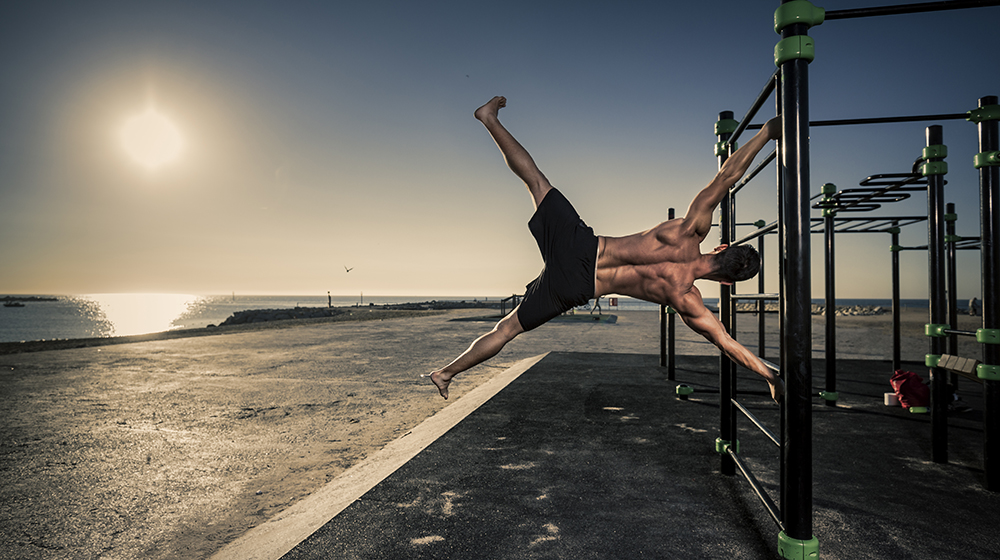
When you hear the word calisthenics, your mind might immediately jump to the more extreme end of the practice, to incredible feats of strength like the human flag. However, at its basic level calisthenics is any kind of bodyweight exercise where you use gravity as resistance, including far less intimidating moves like press-ups and sit-ups.
In this introduction to the discipline, an expert outlines what calisthenics is, how to get started, and how to do three seriously impressive moves. And – if that piques your interest – we've got a beginner's calisthenics workout for you to try, below.
An Introduction To Calisthenics Training
Thanks to the good old internet, the spread of calisthenics videos of extraordinarily ripped people performing moves like the human flag, back levers and muscle-ups has made the practice more popular than ever. Understandably, though, many people are still a little apprehensive about giving it a go, mainly for fear of being asked to hold their body up like a flag in minute one of their first class.
To put your mind at rest on that front, and get more info about calisthenics in general, we spoke to David Jackson, co-founder of the Nottingham-based School of Calisthenics.
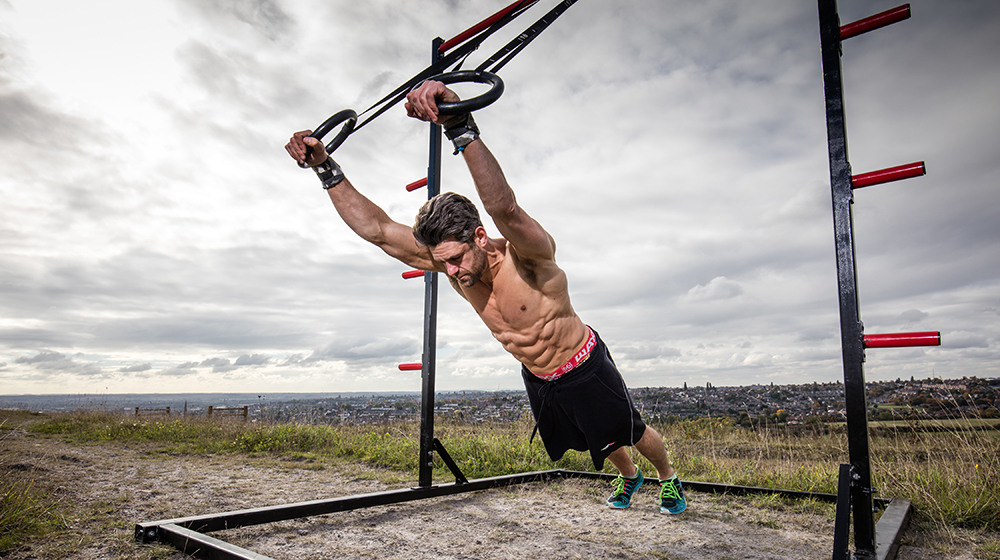
What are the benefits of calisthenics?
“Our tagline is ‘redefine your own impossible’, because these moves look impossible but they can be done – and that goal gives you purpose and motivation,” says Jackson. “Rather than setting generic goals such as ‘I want to be ripped’, with calisthenics we encourage people to work towards a specific outcome. You improve session-on-session until one day you do something that you thought was impossible.
“It took me three months to learn the human flag, but one day I couldn’t do it, the next I could. Your body starts to adapt and you look better, but you’re not doing it purely for aesthetic reasons: you’re trying to achieve something and you have to activate multiple muscle groups at the same time – which is why you get such impressive body benefits. You will also feel incredible mentally.”
How do people get started with calisthenics?
Not with the human flag, put it that way. You start out with bodyweight exercises you probably already know and maybe even already love. The bonus here is that you really don’t need a gym membership or much in the way of equipment.
Get the Coach Newsletter
Sign up for workout ideas, training advice, reviews of the latest gear and more.
“Our beginners’ programme is free and you can get instant access with our Virtual Classroom,” says Jackson. “It has a series of weekly sessions to follow, with a focus on improving and developing the way you move, developing strength with just your bodyweight, and having fun while you do it.”
Is it really possible for normal people?
OK, enough of the basics. Are us normals ever going to be able to do the human flag?
"We gave 12 normal blokes three two-hour workshops to learn to do the human flag,” says Jackson. “On day one they were laughing, but after only six hours of tuition and some practice at home, three were doing it. We want to teach people what to do with their bodies, rather than just show off ourselves. Flexibility and mobility are important, so we help people address what may be restricting them.
“Age doesn’t matter – we had a guy in his 50s who perfected the back lever at one of our workshops. Past injuries aren’t a problem, either. Tim [ Co-founder Tim Stevenson] has dislocated both his shoulders, I’ve broken my shoulder in two places, and dislocated the AC joint in a shoulder. We’re proof you can overcome weaknesses and sore spots.”
How To Do 3 Insane-Looking Calisthenics Moves
Here’s David Jackson’s step-by-step guide to the human flag, back lever and handstand push-ups
Human Flag
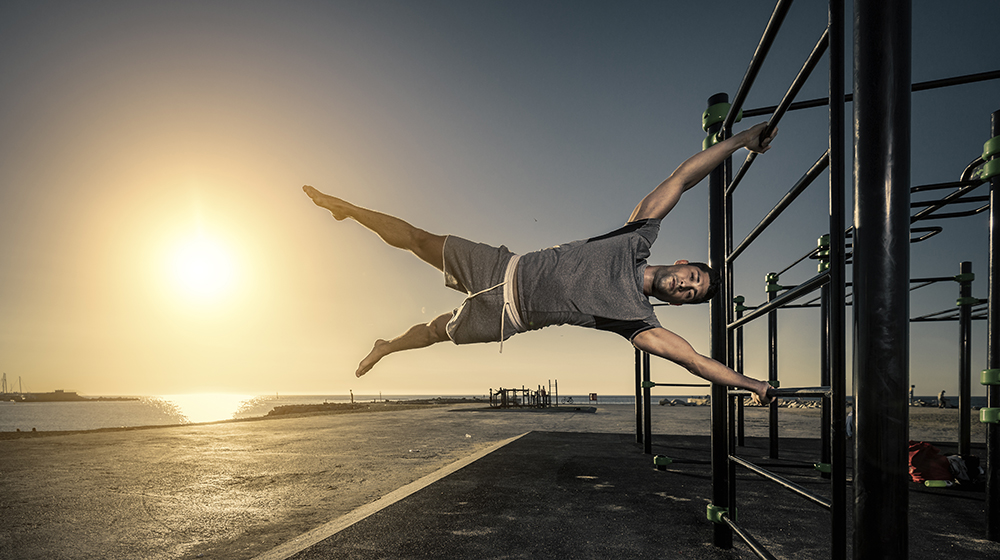
Flexibility check: You need to be able to make a “Y” shape with your arms in the air when you’re standing, because if you can’t, it means you’re too tight through your shoulders to achieve the human flag. You might also have a tight thoracic spine. If that’s the case, address that first with self-massage and stretching.
Step one: Your bottom arm is your pushing arm, which acts like an anchor. Your thumb should point down, palm open. Your top arm is the pulling arm, so with your thumb pointing down – imagine you’re doing an overhand grip pull-up. It’s strange for your brain to push with one arm and pull with the other, but it levers you up and keeps you horizontal.
Step two: Use your pulling arm to draw the shoulder blade back and down, so that you can engage the mid lower traps on that side. Engage your obliques, to pull your hips up and keep them in line with your shoulders. You’ll feel it on the top side of your body.
Step three: Keep your legs together, squeezing quads and hamstrings. Also squeeze your butt cheeks like there’s a £50 note in there and hold your body still in that horizontal line.
Progressions: Build up by starting with your legs in tuck position, then move on to stretching one leg out in a straddled star position, then go the whole hog.
Back Lever
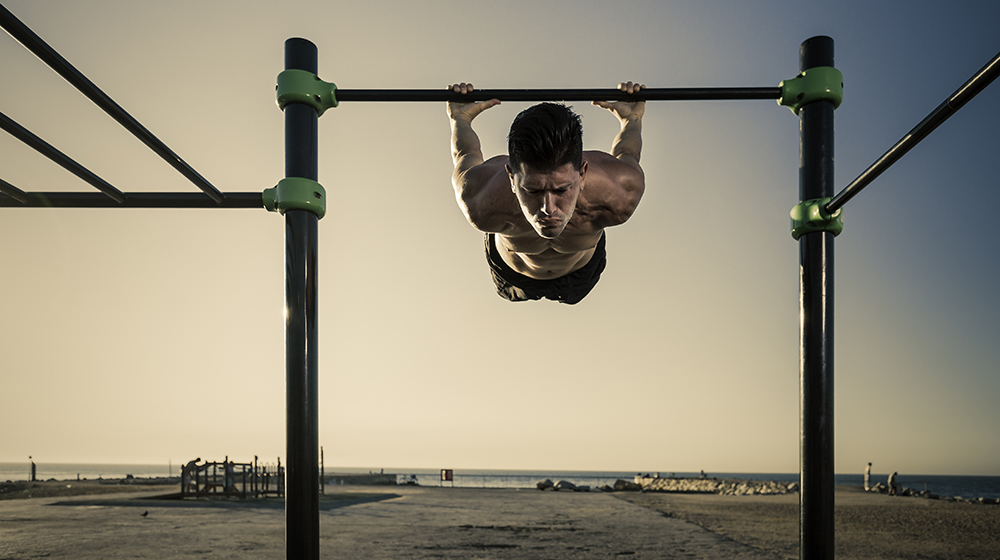
Flexibility check: You need to be able to get full shoulder extensions. To check that, get into position with “skin the cat”. Hold on to a bar or rings, do a backwards roly-poly and hang. If your shoulders are tight, you’ll struggle, so improve that range of motion first.
Step one: “Skin the cat” and once you’re hanging with your arms above you, keep your arms pointing upwards as a beginner before moving to the classic palms-pointing-downwards position because that will put less stress on the bicep.
Step two: Think of a see-saw; it balances because both weights are spaced equally from the centre. In this move, your legs are one weight, your head the other. To pull your legs up and flatten out, pull down on the bar with your hands to reduce the angle your arm is making with your torso. Your hips start to come up, head goes forward and try to pull your hands down towards your hips.
Step three: Straighten your legs out and start to balance. Your glutes are connecting your torso and legs, so they need to be engaged. Squeeze your butt cheeks again and pull your ribcage down as if bracing for a punch.
Progressions: Make it easier by being in a tucked position, pulling your hips up and flattening your back. Then extend one leg, then do both.
Handstand Push-Ups
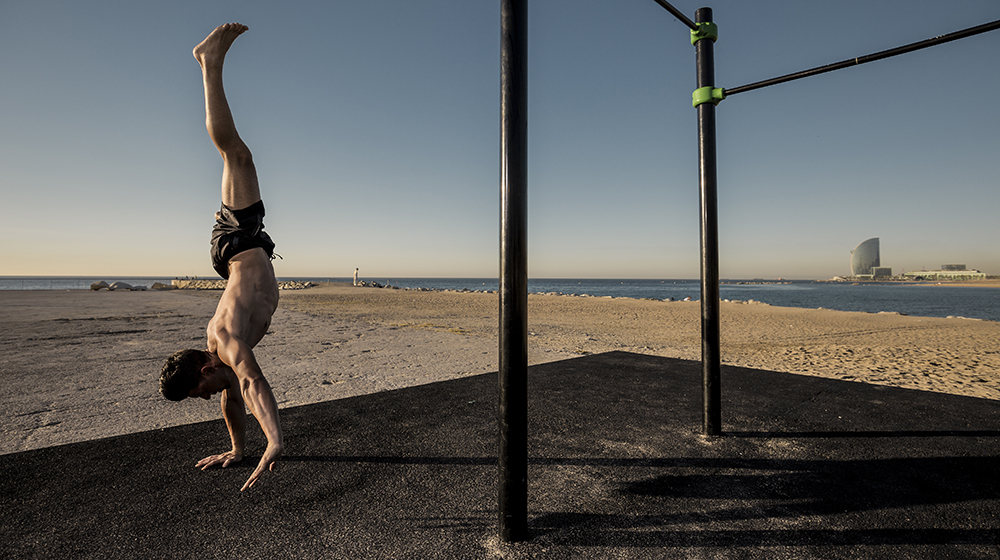
Flexibility check: Check you can get your hands up above your head. You also need wrist mobility, too.
Step one: To practice orientation, lie horizontally between two boxes – one under your shoulders, one under your calves, to get your core, glutes and alignment straight.
Step two: With hands shoulder-width apart, grip the floor with your fingertips and the base of your palm, fingers splayed. Screw your right hand to the right, left hand to the left to externally rotate your shoulder. Put your knees on your inside elbows and take your feet off the floor, lean forward, gripping with your fingertips to balance.
Step three: Pivot forward into a headstand, so you have another point of contact on the floor. Then take your legs up. Stack your bum on top of your shoulders, with your knees bent, then straighten your legs.
Step four: Add a press-up. Keep a straight line in your body but at an 80-degree angle. Your core and glutes will have to work hard to keep you up, but that allows you to take your head forward making a triangle with your elbows and head for push-ups.
Progressions: Start practicing with your back to a wall and walk your feet up. Try arching through your back to help yourself balance.
A Beginner’s Calisthenics Workout To Build Bodyweight Strength
“Calisthenics is a great training method to build lean muscle mass, gain strength and master control of your own body,” says Darren Onyejekwe, a calisthenics specialist otherwise known as Bodyweight D. “If you’re trying to pack on loads of muscle mass, calisthenics isn’t the most efficient option,” says Onyejekwe. “Combined with a sensible diet, it’ll create a lean, defined body, like a gymnast’s.”
“Calisthenics is all about the quality of movement over the quantity,” says Onyejekwe. “A lot of people are attracted to it by the highlight-reel moves, but I’d say make sure you can perform clean, full-range reps of press-ups, dips, pull-ups, squats and hanging knee raises. I respect anyone who’s striving for clean movements and is in full control throughout the entire range of movement.”
How To Do This Workout
“This workout is focused on strength, so the reps are kept low and there’s a decent amount of rest between sets,” says Onyejekwe. “Focus on quality movement.” Do it twice a week, supersetting the moves marked A and B, resting for as long as you need to get through the reps.
1 L-sit hold
Do it on bars, or the edge of a sofa/chair. If you can’t manage the full version, tuck your legs.
2A Pull-up
Sets 5 Reps 5
Aim to pull your elbows behind you, and touch your collarbone to the bar on each rep.
2B Dip
Sets 5 Reps 5 Rest 1-3min
Lower until your upper arms are parallel to the floor, pause, and push back up.
3A Press-up
Sets 5 Reps 10
Keep your hands under your shoulders, tuck your elbows to your sides, and touch your chest to the floor on each rep.
3B Inverted row
Sets 5 Reps 10 Rest 1-3min
Lie under a bar/Smith machine with your feet flat and body straight. Pull up until your chest touches the bar, pause and lower.
4 Hollow body hold
Sets 5 Time 60sec Rest 1-2min
Lie on the floor, then bring your hands above your head, arms straight, and feet off the floor. Hold it.
5 Superman hold
Sets 5 Time 60sec Rest 1-2min
From the hollow hold, roll onto your front and do the reverse, Man of Steel-style. It’ll build near-bulletproof abs.
6A Unweighted squat
Sets 5 Reps 20
With your feet shoulder-width apart, squat down until your thighs are parallel to the floor, pause, and stand up.
6B Half bridge
Sets 5 Reps 12 Rest 1-2min
Lie on the floor with your feet close to your glutes. Drive your hips up in the air, pause and lower.
Instant Expertise
Know your scapula
“Your shoulder blades can sit in four positions: protraction, retraction, elevation and depression,” says Onyejekwe. “Even people who can do the advanced skills often don’t have a clue which position they’re using.” The scapula pull-up will help with retraction and depression: hang from a bar, and keep your elbows straight back as you pull your shoulder blades together, aiming to get your shoulders away from your ears.
Unleash L
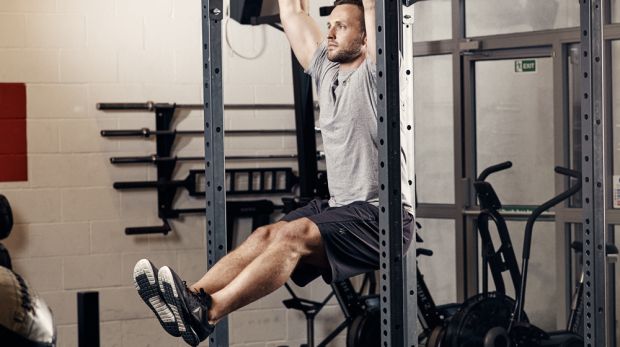
Make the L-sit your new favourite abs move. “This static position should be one of the first skills you learn,” says Onyejekwe. “But most people will need to work on their core strength and hip flexors.” If you can’t do the full thing - hands on the floor, legs out – start between two chairs, holding your thighs horizontal with knees bent. Do 60 seconds of this in as few sets as possible, twice a week.
Laura Potter is an experienced writer and editor who contributed to Coach magazine in 2016. Laura specialises in health, nutrition, fitness and wellbeing, and has written for a wide range of publications including The Guardian's Saturday magazine, Women's Health UK, Men's Health UK, Stylist, Men's Fitness UK, Healthy magazine, Cosmo Body and Netdoctor.









